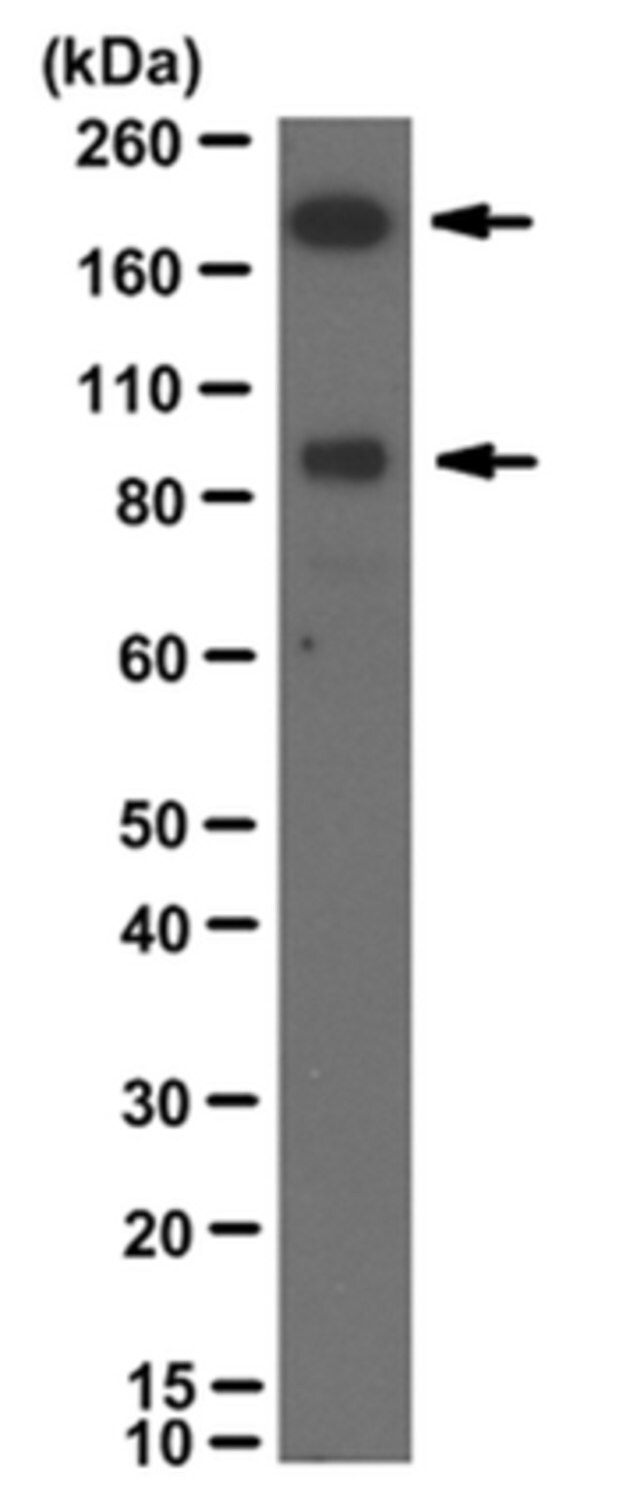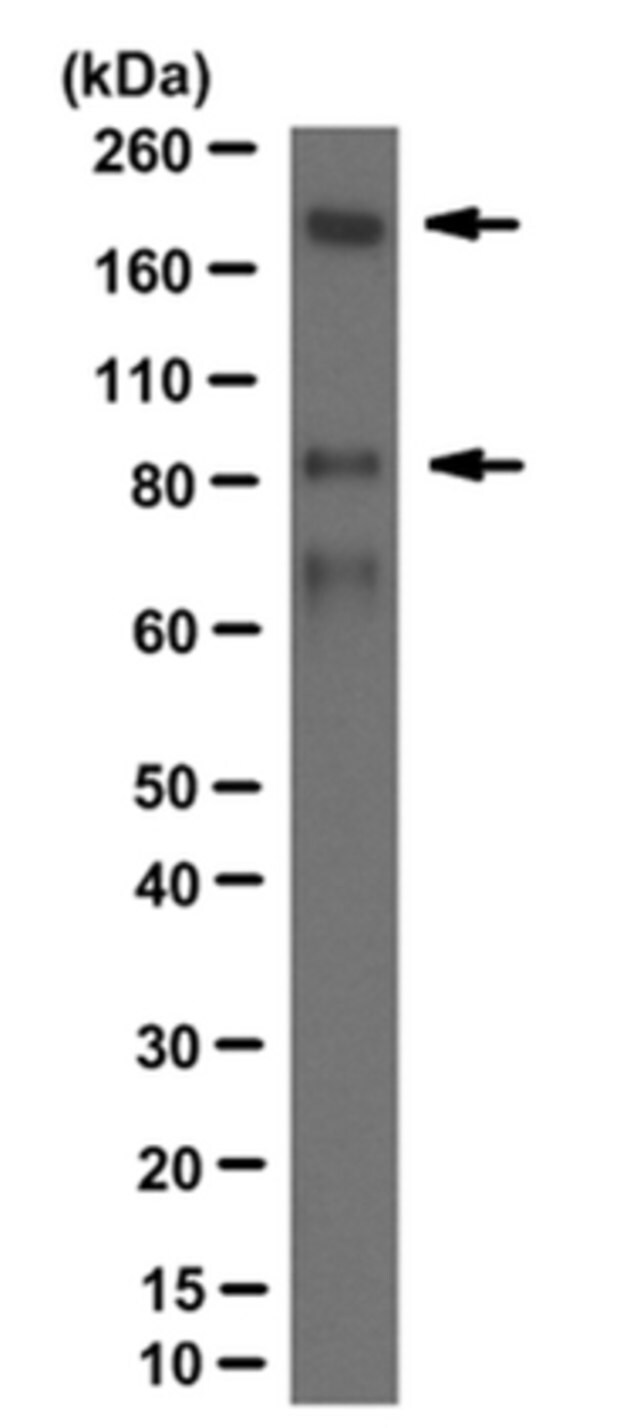您的位置:首页 > 产品中心 > Anti-PTPRT Antibody, clone 1F7
Anti-PTPRT Antibody, clone 1F7

产品别名
Anti-PTPRT Antibody, clone 1F7
Receptor-type tyrosine-protein phosphatase T, R-PTP-T, RPTP-rho, RPTPrho, PTPRT
基本信息
| eCl@ss | 32160702 |
| NACRES | NA.41 |
| General description【一般描述】 | Receptor-type tyrosine-protein phosphatase T (EC 3.1.3.48; UniProt O14522; also known as R-PTP-T, Receptor protein tyrosine phosphatase, Receptor-type tyrosine-protein phosphatase rho, RPTP-rho, RPTPrho) is encoded by the PTPRT (also known as KIAA0283) gene (Gene ID 11122) in human. RPTPrho/PTPRT is a member of the R2B subfamily of receptor-type protein tyrosine phosphatases (R-PTPs). Known RPTPrho/PTPRT substrates include BCR (Tyr177), paxillin (Tyr188), and STAT3 (Tyr705). In addition, in vitro pull-downs and cell-free dephosphorylation assays also suggest cadherin and catenin family of cell adhesion molecules as physiological substrates of RPTPrho/PTPRT. PTPRT is the single most commonly mutated PTPR gene in all sequenced human cancers, with the highest PTPRT mutation frequency found in cutaneous melanoma. Among 16 tumor types examined, 37.9% of PTPRT mutations are found in the catalytic (PTPase) domain and 33.0% in the extracellular fibronectin type III-like (FN3) domain. In head and neck squamous cell carcinoma (HNSCC), 45.5% PTPRT mutations are located in the PTPase domain, leading to up-regulated STAT3 phosphorylation in HNSCC tumors. |
| Specificity【特异性】 | Clone 1F7 reacts with the full-length PTPRT as well as cleaved/truncated PTPRT forms that contain the two phosphatase domains. |
| Immunogen【免疫原】 | GST-tagged recombinant protein corresponding to the PTPase domains 1/2 of human PTPRT. Epitope: PTPase domains 1/2 |
| Application【应用】 | Western Blotting Analysis: 1.0 µg/mL of this antibody detected the full-length and cleaved forms of PTPRT in rat brain tissue lysate. Western Blotting Analysis: 0.5 µg/mL of this antibody detected the full-length and a cleaved form of PTPRT in brain and liver homogenates from wild-type, but not PTPRT-knockout mice (Courtesy of Dr. Zhenghe Wang, Case Western Reserve University, Cleveland, OH). Western Blotting Analysis: 2.0 µg/mL of this antibody detected the full-length and a cleaved form of PTPRT in small intestine epithelium homogenate from wild-type mice (Courtesy of Dr. Zhenghe Wang, Case Western Reserve University, Cleveland, OH). Western Blotting Analysis: A representative lot detected exogenously expressed human PTPRT using transiently transfected HNCC CAL-33 (squamous carcinomas of the tongue) cells expressing wild-type, PTPase domain mutatant (A1022E), or FN3-domain mutatant (P497T) PTPRT, as well as in transfected HNSCC PCI-52-SD1 cells stably expressing wild-type human PTPRT (Lui, V.W., et al. (2014). Proc. Natl. Acad. Sci. U.S.A. 111(3):1114-1119). Anti-PTPRT Antibody, clone 1F7 is an antibody against PTPRT for use in Western Blotting. Research Category Signaling Research Sub Category Developmental Signaling |
| Quality【质量】 | Evaluated by Western Blotting in mouse brain tissue lysate. Western Blotting Analysis: 0.5 µg/mL of this antibody detected the full-length and a cleaved form of PTPRT in mouse brain tissue lysate. |
| Physical form【外形】 | Purified mouse monoclonal IgG1κ antibody in buffer containing 0.1 M Tris-Glycine (pH 7.4), 150 mM NaCl with 0.05% sodium azide. Format: Purified Protein G Purified |
| Other Notes【其他说明】 | Concentration: Please refer to lot specific datasheet. |
产品性质
| Quality Level【质量水平】 | 100 |
| biological source【生物来源】 | mouse |
| antibody form【抗体形式】 | purified immunoglobulin |
| antibody product type | primary antibodies |
| clone【克隆】 | 1F7, monoclonal |
| species reactivity | rat, human, mouse |
| technique(s) | western blot: suitable |
| isotype【同位素/亚型】 | IgG1κ |
| NCBI accession no.【NCBI登记号】 | NP_008981 |
| UniProt accession no.【UniProt登记号】 | O14522 |
| shipped in【运输】 | wet ice |
| Gene Information | human ... PTPRT(11122) |
产品说明
| Target description【目标描述】 | ~ 190/90 kDa observed. Due to glycosylation, the full-length target band (~190 kDa) appears larger than the calculated molecular weight (162.1 kDa). Cleaved/truncated forms between ~70 kDa to 120 kDa can also be detected. It is believed that PTPRT is proteolytically cleaved upon activation. The intracellular portion containing the two protein tyrosine phosphatase (PTPase) domains then translocates into nucleus, where it dephosphorylates STAT3 (Zhang, X., et al. (2007). Proc. Natl. Acad. Sci. U.S.A. 104(10):4060-4064). |
| Storage and Stability【储存及稳定性】 | Stable for 1 year at 2-8°C from date of receipt. |
| Disclaimer【免责声明】 | Unless otherwise stated in our catalog or other company documentation accompanying the product(s), our products are intended for research use only and are not to be used for any other purpose, which includes but is not limited to, unauthorized commercial uses, in vitro diagnostic uses, ex vivo or in vivo therapeutic uses or any type of consumption or application to humans or animals. |
安全信息
| Storage Class Code【储存分类代码】 | 12 - Non Combustible Liquids |
| WGK | WGK 1 |






